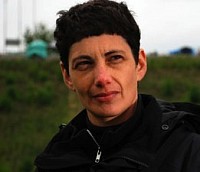BIOGRAPHY

1970-
Yael Bartana is a video artist who explores the imagery of cultural identity. In her photographs, films and installations Bartana critically investigates her native country's struggle for identity. Her early work documents collective rituals introducing alienation effects such as slow-motion and sound. In her recent work the artist stages situations and introduces fictive moments into real existing narratives.
She studied at the Bezalel Academy of Arts and Design, Jerusalem, the School of Visual Arts, New York and the Rijksakademie in Amsterdam. Her solo exhibitions include the Moderna Museet in Malmö, the Museum of Modern Art in Warsaw, PS1 in New York, the Center for Contemporary Art in Tel Aviv, the Kunstverein in Hamburg and the Van Abbemuseum in Eindhoven. She participated in the Sao Paolo Biennial (2010 and 2006), Documenta 12 in Kassel and the Istanbul Biennial. In 2011, Bartana represented Poland for the 54th edition of the Venice Biennial.
Among other prizes, Bartana was awarded the prestigious Artes Mundi 4 in 2010. Her work has been included in numerous public collections, amongst others at the Museum of Modern Art in New York, the Centre Pompidou in Paris, Tate Modern in London and the Van Abbemuseum in Eindhoven.
Description of Jews Return Jews Return Jews Return…:
Bartana's diptych Jews Return Jews Return Jews Return..., shows a double portrait of Polish left-wing publicist Slawomir Sierakowski, speaking. The subtitles in the image reveal he is speaking the words 'Jews' and 'Return'. This work corresponds to Bartana's video work Mary Koszmary (2007). In this work, to the sounds of the Polish national anthem, Slawomir Sierakowski strides into a huge, empty stadium in Warsaw. In a breathtaking speech, he asks three million Jews to return to their homeland to help the Poles deal with their nightmares. Mary Koszmary (Nightmares) is the first part of the Polish trilogy … and Europe will be stunned. The second part of the trilogy is Mur I Wieza (Wall and Tower, 2009), which is an answer to Sierakowski's provocation. A group of young people dressed in costumes, mocking the 1930s East European pioneer Jews, are returning to Warsaw to construct a Wall and Tower settlement reminiscent of the Wall and Tower settlements built in the 1930s in the Palestinian territory. They erect the settlement in the place where the Warsaw Ghetto was located during World War II, beside the Heroes of the Ghetto monument. While Sierakowski watches, these young people, after finishing the construction, raise a blood-red flag bearing a symbol that combines the Star of David and the Polish eagle on the observatory tower in the middle of the settlement. The symbol is of the fictional Jewish Renaissance Movement in Poland, founded by the artist. Through heroic images and the sounds of young men building a new country, Bartana's film mirrors and displays the Zionist dream. The third part of the trilogy was presented in the Polish pavilion at the Venice Biennial in 2011.
